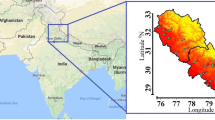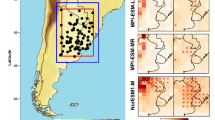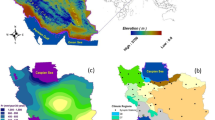Abstract
The authors have applied an automated regression-based statistical method, namely, the automated statistical downscaling (ASD) model, to downscale and project the precipitation climatology in an equatorial climate region (Peninsular Malaysia). Five precipitation indices are, principally, downscaled and projected: mean monthly values of precipitation (Mean), standard deviation (STD), 90th percentile of rain day amount, percentage of wet days (Wet-day), and maximum number of consecutive dry days (CDD). The predictors, National Centers for Environmental Prediction (NCEP) products, are taken from the daily series reanalysis data, while the global climate model (GCM) outputs are from the Hadley Centre Coupled Model, version 3 (HadCM3) in A2/B2 emission scenarios and Third-Generation Coupled Global Climate Model (CGCM3) in A2 emission scenario. Meanwhile, the predictand data are taken from the arithmetically averaged rain gauge information and used as a baseline data for the evaluation. The results reveal, from the calibration and validation periods spanning a period of 40 years (1961–2000), the ASD model is capable to downscale the precipitation with reasonable accuracy. Overall, during the validation period, the model simulations with the NCEP predictors produce mean monthly precipitation of 6.18–6.20 mm/day (root mean squared error 0.78 and 0.82 mm/day), interpolated, respectively, on HadCM3 and CGCM3 grids, in contrast to 6.00 mm/day as observation. Nevertheless, the model suffers to perform reasonably well at the time of extreme precipitation and summer time, more specifically to generate the CDD and STD indices. The future projections of precipitation (2011–2099) exhibit that there would be an increase in the precipitation amount and frequency in most of the months. Taking the 1961–2000 timeline as the base period, overall, the annual mean precipitation would indicate a surplus projection by nearly 14~18 % under both GCM output cases (HadCM3 A2/B2 scenarios and CGCM3 A2 scenario). According to the model simulation, the September–November periods might be the more significant months projecting the increment of the precipitation amount around over 50 %, while the precipitation deficit would be seen in March–May periods.

















Similar content being viewed by others
References
Burger G, Murdock TQ, Werner AT, Sobie SR, Cannon AJ (2012) Downscaling extremes—an intercomparison of multiple statistical methods for present climate. J Clim 25(12):4366–4388. doi:10.1175/jcli-d-11-00408.1
Chadwick R, Coppola E, Giorgi F (2011) An artificial neural network technique for downscaling GCM outputs to RCM spatial scale. Nonlinear Process Geophys 18(6):1013–1028. doi:10.5194/npg-18-1013-2011
Chen ST, Yu PS, Tang YH (2010) Statistical downscaling of daily precipitation using support vector machines and multivariate analysis. J Hydrol 385(1–4):13–22. doi:10.1016/j.jhydrol.2010.01.021
Chen J, Brissette FP, Leconte R (2012) Coupling statistical and dynamical methods for spatial downscaling of precipitation. Clim Chang 114(3–4):509–526. doi:10.1007/s10584-012-0452-2
Chu JT, Xia J, Xu CY, Singh VP (2010) Statistical downscaling of daily mean temperature, pan evaporation and precipitation for climate change scenarios in Haihe River, China. Theor Appl Climatol 99(1–2):149–161. doi:10.1007/s00704-009-0129-6
Colette A, Vautard R, Vrac M (2012) Regional climate downscaling with prior statistical correction of the global climate forcing. Geophys Res Lett 39:L13707. doi:10.1029/2012GL052258
Dibike YB, Coulibaly P (2005) Hydrologic impact of climate change in the Saguenay watershed: comparison of downscaling methods and hydrologic models. J Hydrol 307(1–4):145–163. doi:10.1016/j.hydrol.2004.10.012
Fan LJ, Fu CB, Chen DL (2011) Long-term trend of temperature derived by statistical downscaling based on EOF analysis. Acta Meteorol Sin 25(3):327–339. doi:10.1007/s13351-011-0308-0
Fatichi S, Ivanov VY, Caporali E (2011) Simulation of future climate scenarios with a weather generator. Adv Water Resour 34(4):448–467. doi:10.1016/j.advwatres.2010.12.013
Flato GM, Boer GJ (2001) Warming asymmetry in climate change simulations. Geophys Res Lett 28(1):195–198. doi:10.1029/2000gl012121
Ghosh S, Mujumdar PP (2008) Statistical downscaling of GCM simulations to streamflow using relevance vector machine. Adv Water Resour 31(1):132–146. doi:10.1016/j.advwatres.2007.07.005
Girod B, Wiek A, Mieg H, Hulme M (2009) The evolution of the IPCC's emissions scenarios. Environ Sci Policy 12(2):103–118. doi:10.1016/j.envsci.2008.12.006
Gordon C, Cooper C, Senior CA, Banks H, Gregory JM, Johns TC, Mitchell JFB, Wood RA (2000) The simulation of SST, sea ice extents and ocean heat transports in a version of the Hadley Centre coupled model without flux adjustments. Clim Dyn 16(2–3):147–168. doi:10.1007/s003820050010
Goyal MK, Burn DH, Ojha CSP (2012) Statistical downscaling of temperatures under climate change scenarios for Thames river basin, Canada. Int J Global Warm 4(1):13–30. doi:10.1504/12.47263
Guo J, Chen H, Xu CY, Guo SL, Guo JL (2012) Prediction of variability of precipitation in the Yangtze River Basin under the climate change conditions based on automated statistical downscaling. Stoch Environ Res Risk A 26(2):157–176. doi:10.1007/s00477-011-0464-x
Gutmann ED, Rasmussen RM, Liu CH, Ikeda K, Gochis DJ, Clark MP, Dudhia J, Thompson G (2012) A comparison of statistical and dynamical downscaling of winter precipitation over complex terrain. J Clim 25(1):262–281. doi:10.1175/2011jcli4109.1
Hammami D, Lee TS, Ouarda T, Lee J (2012) Predictor selection for downscaling GCM data with LASSO. J Geophys Res-Atmos 117:D17116. doi:10.1029/2012JD017864
Hashmi MZ, Shamseldin AY, Melville BW (2011) Comparison of SDSM and LARS-WG for simulation and downscaling of extreme precipitation events in a watershed. Stoch Environ Res Risk A 25(4):475–484. doi:10.1007/s00477-010-0416-x
Hessami M, Gachon P, Ouarda T, St-Hilaire A (2008) Automated regression-based statistical downscaling tool. Environ Model Softw 23(6):813–834. doi:10.1016/j.envsoft.2007.10.004
Huang J, Zhang JC, Zhang ZX, Xu CY, Wang BL, Yao J (2011) Estimation of future precipitation change in the Yangtze River basin by using statistical downscaling method. Stoch Environ Res Risk A 25(6):781–792. doi:10.1007/s00477-010-0441-9
Ishak AM, Bray M, Remesan R, Han DW (2010) Estimating reference evapotranspiration using numerical weather modelling. Hydrol Process 24(24):3490–3509. doi:10.1002/hyp.7770
Ishak AM, Bray M, Remesan R, Han DW (2012) Seasonal evaluation of rainfall estimation by four cumulus parameterization schemes and their sensitivity analysis. Hydrol Process 26(7):1062–1078. doi:10.1002/hyp.8194
Islam T, Rico-Ramirez MA, Han DW, Srivastava PK (2012a) A Joss-Waldvogel disdrometer derived rainfall estimation study by collocated tipping bucket and rapid response rain gauges. Atmos Sci Lett 13(2):139–150. doi:10.1002/asl.376
Islam T, Rico-Ramirez MA, Han DW, Srivastava PK, Ishak AM (2012b) Performance evaluation of the TRMM precipitation estimation using ground-based radars from the GPM validation network. J Atmos Sol-Terr Phys 77:194–208. doi:10.1016/j.jastp.2012.01.001
Jeong DI, St-Hilaire A, Ouarda T, Gachon P (2012) CGCM3 predictors used for daily temperature and precipitation downscaling in Southern Quebec, Canada. Theor Appl Climatol 107(3–4):389–406. doi:10.1007/s00704-011-0490-0
Kalnay E, Kanamitsu M, Kistler R, Collins W, Deaven D, Gandin L, Iredell M, Saha S, White G, Woollen J, Zhu Y, Chelliah M, Ebisuzaki W, Higgins W, Janowiak J, Mo KC, Ropelewski C, Wang J, Leetmaa A, Reynolds R, Jenne R, Joseph D (1996) The NCEP/NCAR 40-year reanalysis project. Bull Amer Meteorol Soc 77 (3):437–471. doi:10.1175/1520-0477(1996)077<0437:tnyrp>2.0.co;2
Kannan S, Ghosh S (2011) Prediction of daily rainfall state in a river basin using statistical downscaling from GCM output. Stoch Environ Res Risk A 25(4):457–474. doi:10.1007/s00477-010-0415-y
Kim SJ, Flato GM, Boer GJ, McFarlane NA (2002) A coupled climate model simulation of the Last Glacial Maximum, part 1: transient multi-decadal response. Clim Dyn 19(5–6):515–537. doi:10.1007/s00382-002-0243-y
Kim SJ, Flato GM, Boer GJ (2003) A coupled climate model simulation of the last glacial maximum, part 2: approach to equilibrium. Clim Dyn 20(6):635–661. doi:10.1007/s00382-002-0292-2
Koukidis EN, Berg AA (2009) Sensitivity of the statistical downscaling model (SDSM) to reanalysis products. Atmos-Ocean 47(1):1–18. doi:10.3137/ao924.2009
Liu LL, Liu ZF, Ren XY, Fischer T, Xu Y (2011a) Hydrological impacts of climate change in the Yellow River Basin for the 21st century using hydrological model and statistical downscaling model. Quat Int 244(2):211–220. doi:10.1016/j.quaint.2010.12.001
Liu ZF, Xu ZX, Charles SP, Fu GB, Liu L (2011b) Evaluation of two statistical downscaling models for daily precipitation over an arid basin in China. Int J Climatol 31(13):2006–2020. doi:10.1002/joc.2211
Najafi MR, Moradkhani H, Wherry SA (2011) Statistical downscaling of precipitation using machine learning with optimal predictor selection. J Hydrol Eng 16(8):650–664. doi:10.1061/(asce)he.1943-5584.0000355
Pope VD, Gallani ML, Rowntree PR, Stratton RA (2000) The impact of new physical parametrizations in the Hadley Centre climate model: HadAM3. Clim Dyn 16(2–3):123–146. doi:10.1007/s003820050009
Qian B, Gameda S, Hayhoe H (2008) Performance of stochastic weather generators LARS-WG and AAFC-WG for reproducing daily extremes of diverse Canadian climates. Clim Res 37(1):17–33. doi:10.3354/cr00755
Reichler T, Kim J (2008) How well do coupled models simulate today's climate? Bull Amer Meteorol Soc 89 (3):303-311. doi:10.1175/bams-89-3-303
Saha S, Moorthi S, Pan HL, Wu XR, Wang JD, Nadiga S, Tripp P, Kistler R, Woollen J, Behringer D, Liu HX, Stokes D, Grumbine R, Gayno G, Wang J, Hou YT, Chuang HY, Juang HMH, Sela J, Iredell M, Treadon R, Kleist D, Van Delst P, Keyser D, Derber J, Ek M, Meng J, Wei HL, Yang RQ, Lord S, Van den Dool H, Kumar A, Wang WQ, Long C, Chelliah M, Xue Y, Huang BY, Schemm JK, Ebisuzaki W, Lin R, Xie PP, Chen MY, Zhou ST, Higgins W, Zou CZ, Liu QH, Chen Y, Han Y, Cucurull L, Reynolds RW, Rutledge G, Goldberg M (2010) The NCEP climate forecast system reanalysis. Bull Am Meteorol Soc 91(8):1015–1057. doi:10.1175/2010bams3001.1
Srikanthan R, McMahon TA (2001) Stochastic generation of annual, monthly and daily climate data: a review. Hydrol Earth Syst Sci 5(4):653–670
Stott PA, Tett SFB, Jones GS, Allen MR, Mitchell JFB, Jenkins GJ (2000) External control of 20th century temperature by natural and anthropogenic forcings. Science 290(5499):2133–2137. doi:10.1126/science.290.5499.2133
Sunyer MA, Madsen H, Ang PH (2012) A comparison of different regional climate models and statistical downscaling methods for extreme rainfall estimation under climate change. Atmos Res 103:119–128. doi:10.1016/j.atmosres.2011.06.011
Teutschbein C, Wetterhall F, Seibert J (2011) Evaluation of different downscaling techniques for hydrological climate-change impact studies at the catchment scale. Clim Dyn 37(9–10):2087–2105. doi:10.1007/s00382-010-0979-8
Timbal B, Fernandez E, Li Z (2009) Generalization of a statistical downscaling model to provide local climate change projections for Australia. Environ Model Softw 24(3):341–358. doi:10.1016/j.envsoft.2008.07.007
Tolika K, Anagnostopoulo C, Maheras P, Vafiadis M (2008) Simulation of future changes in extreme rainfall and temperature conditions over the Greek area: a comparison of two statistical downscaling approaches. Global Planet Chang 63(2–3):132–151. doi:10.1016/j.gloplacha.2008.03.005
Tryhorn L, DeGaetano A (2011) A comparison of techniques for downscaling extreme precipitation over the Northeastern United States. Int J Climatol 31(13):1975–1989. doi:10.1002/joc.2208
Van Vuuren DP, O'Neill BC (2006) The consistency of IPCC's SRES scenarios to recent literature and recent projections. Clim Chang 75(1–2):9–46. doi:10.1007/s10584-005-9031-0
Wetterhall F, Bardossy A, Chen DL, Halldin S, Xu CY (2009) Statistical downscaling of daily precipitation over Sweden using GCM output. Theor Appl Climatol 96(1–2):95–103. doi:10.1007/s00704-008-0038-0
Wilby RL, Dawson CW, Barrow EM (2002) SDSM—a decision support tool for the assessment of regional climate change impacts. Environ Model Softw 17(2):147–159
Wilks DS (2010) Use of stochastic weather generators for precipitation downscaling. Wiley Interdiscip Rev-Clim Chang 1(6):898–907. doi:10.1002/wcc.85
Yang TC, Yu PS, Wei CM, Chen ST (2011) Projection of climate change for daily precipitation: a case study in Shih-Men reservoir catchment in Taiwan. Hydrol Process 25(8):1342–1354. doi:10.1002/hyp.7883
Acknowledgments
The author(s) would like to acknowledge the Data Access Integration (DAI, see http://quebec.ccsn.ca/DAI/) Team for providing the data and technical support. The DAI data download gateway is made possible through collaboration among the Global Environmental and Climate Change Centre (GEC3), the Adaptation and Impacts Research Division of Environment Canada, and the Drought Research Initiative (DRI). The Ouranos Consortium (in Québec) also provides IT support to the DAI team. This research is funded by the Hydrology and Water Resources Division, DID, Ministry of Water Resources, Malaysia.
Author information
Authors and Affiliations
Corresponding author
Rights and permissions
About this article
Cite this article
Amin, M.Z.M., Islam, T. & Ishak, A.M. Downscaling and projection of precipitation from general circulation model predictors in an equatorial climate region by the automated regression-based statistical method. Theor Appl Climatol 118, 347–364 (2014). https://doi.org/10.1007/s00704-013-1062-2
Received:
Accepted:
Published:
Issue Date:
DOI: https://doi.org/10.1007/s00704-013-1062-2




